It is difficult to believe that we’re already embarking on our second year of beekeeping!
Despite struggling with Varroa mites last fall, and losing two weaker colonies in our apiary over fall and winter, one to robbers, and the other to a Queen that abdicated, the last few weeks it’s been apparent that our two surviving colonies of bees are building up FAST.
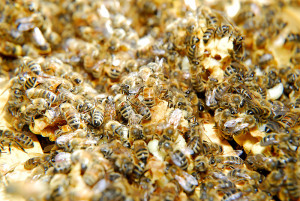
This was the view under the inner cover on Friday, at the top of the sixth hive body in the Salvia hive (click any image to enlarge)
Our weather has been so mild and warm for most of the year so far, reaching well into the 70s some afternoons, that hive activity is surging. Standing in the garden during a warm spell last week, all we could smell was the sweet aroma of honey, and beeswax. Pure heaven!
With all the comings and goings at the hive entrances though, coupled with our faux-spring weather, we’ve been a little nervous about our largest colony, Salvia, initiating an early season swarm. This feral-source colony has done so well for us since the minute we housed them, after rescuing them from our neighbor’s plum tree, that we’d hate to lose this Queen to a swarm.
Of all the bees in a colony, the only bee that can reproduce is the Queen. New colonies are created in the spring when healthy, and robust, honey bee colonies cast swarms.
A swarm consists of a large pool of worker bees from the colony, a few scout bees, and the colony’s Queen. The swarm leaves the colony together in search of a new home. Meanwhile, the bees remaining in the parent colony raise a replacement heir to the throne.
If a colony becomes overcrowded, multiple swarms may be cast during a season to reduce the colony size, making room in the hive, until the population becomes more manageable. This is how we acquired the Lavender colony last year, as a secondary swarm from the same hive that the Salvia colony came from. Swarming is simply a sign that a honey bee colony is doing well, and has outgrown its accommodation. Weak colonies typically don’t swarm.
Recently it’s been challenging for us to find time to do anything that isn’t to do with preparing for the arrival of goats this spring, but the weather Friday was perfect for opening the hive. Keeping an eye on extended forecasts, we decided to chance dividing the Salvia colony with an early season split. Splitting a colony can be thought of as an artificial ‘controlled’ swarm.
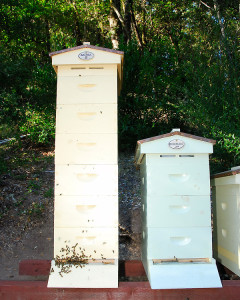
By moving some of the bees from the Salvia hive (left), into the empty Rosemary hive (right), we decrease the crowding pressure in the hive, and decrease the chance that Salvia will swarm
In theory it achieves the same end as allowing the colony to swarm naturally, except that the beekeeper decreases the likelihood of losing the bees into the environment. It helps to free up space in a crowded hive, and has the benefit of increasing the number of colonies in the apiary. This spring our hope is that by dividing our strong surviving colonies we will be able to replace the two colonies we lost this last winter. Also, by dividing these colonies, we hope that we are also selecting for stronger, more robust bees. These colonies clearly were much MUCH stronger than either of our package hives last year, and perfectly capable of producing enough hardy bees to make it through winter.
So, with the weather in our favor, we rounded up plenty of empty hive bodies, and drawn combs, grabbed the smoker, and headed out to the apiary.
To split the Salvia hive we first had to find which level of the hive the brood nest was located in, and then to split the brood nest more or less equally between Salvia, and the empty Rosemary hive (which was vacated in January when the Queen flew off).
We essentially did what is termed a ‘walk-away’ split. There are many methods of splitting honey bee colonies, but with as hectic as things are here at the moment, we chose to keep it simple, and ‘walk-away’ splits are perhaps the most straightforward, as you simply strive to divide the colony equally between two hives. The most important thing was to ensure that we ended up with eggs, young larvae, and capped brood, along with plenty of nurse bees, in BOTH colonies at the end of the split. Providing there are (female) eggs within a hive, and enough worker bees to tend them, a colony can raise a new Queen.
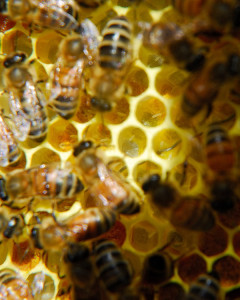
Eggs are required for the new colony to raise a new Queen, but all lifestages of brood must be present in the hive before performing a split
We pulled the Vivaldi board off the top of Salvia, and were immediately surprised to find the uppermost hive body completely crowded with bees.
As we worked our way down into the start of the brood nest we found plenty of honey stores, lots of vibrant colored pollen, and plenty of brood.
We transferred a couple of frames of capped brood to the new colony, so that newly emerging bees will join the new colony as extra nurse bees, along with frames with larvae, eggs, pollen, and honey. Our goal was to split Salvia in half, although at the end of the day, I think we more realistically split about a third of the colony into the empty Rosemary hive. It was somewhat challenging juggling Salvia’s six hive bodies during the split, and transferring frames, as this colony was so large to start with.
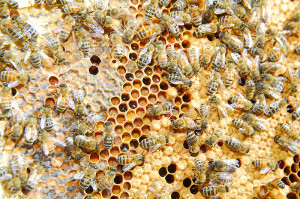
The brood nest frames had capped honey (left), pollen (middle), and plenty of capped and uncapped brood (right)
The bottom hive body, where the bees would have overwintered, was mostly empty, as the colony has moved up inside the hive with the recent warm weather. We reversed the bottom hive body as those empty frames provide valuable space for the Queen to lay more eggs.
We checkerboarded some of those empty combs in to part of the brood nest, as well as in between the honey frames. Some beekeepers say to never checkerboard empty combs in the brood nest, but we’ve done it before, and if the brood nest is crowded, it immediately provides extra space for the Queen to lay eggs, without worrying whether or not she’ll move up to an empty super. We wouldn’t divide the brood nest in the fall, or in cold weather, but at the moment our temperatures are quite mild.
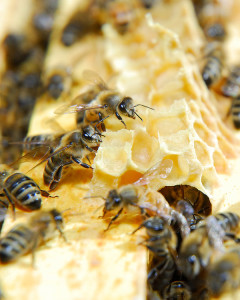
The bees were so crowded, that the bottom of almost every frame had burr comb built up underneath, most of which was packed with drone larvae
We found a row of empty Queen cups at the bottom of one of Salvia’s frames, so we moved those Queen cups into the new (Queenless) Rosemary hive.
We had somewhat hoped to find capped Queen cells, with as active as Salvia is, as we could have transferred those to the Queenless Rosemary colony, and decreased the amount of time it will take for them to raise a new Queen. However, providing we transferred enough bees, and brood, to the new colony, they should have no difficulty raising a new Queen of their own over the next couple of weeks.
Working with a hive as large as Salvia was somewhat intimidating, at least in so far as not having any idea where the Salvia Queen was during this split. I think all beekeepers live in fear of inadvertently harming the Queen when they work their hives, especially good Queens like Salvia. The entire point of this exercise was not only to replace one of our lost hives in the apiary, but also to preserve the Salvia Queen. However, we have never found the Queen in the Salvia colony, which is somewhat embarrassing, due to the sheer size of the population in this hive, and despite our best efforts we still didn’t sight her on Friday. We’re fairly certain she’s still in the hive, but it’s not impossible we moved her accidentally. If by some unfortunate chance we managed to drop, crush, transfer, or otherwise lose the Queen during our rather invasive hive manipulations on Friday though (perish the thought), we’ve made sure that Salvia could still raise an emergency Queen if needed, just as Rosemary 2.0 will now need to raise a Queen for that colony to survive.
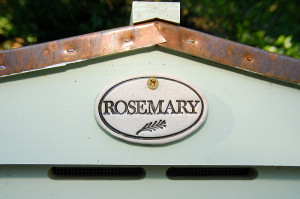
The Rosemary hive has now been repopulated with bees from Salvia. We're crossing our fingers they can raise a new Queen in a few weeks
If all goes well, the new Rosemary colony will transform one or more eggs into Queen cells, and raise a new Queen (which takes up to 16 days). Providing the weather holds, soon thereafter she will then embark on her mating flight (and there is NO shortage of drones here at the moment for her to mate with), and then we will check, in about three to four weeks, to see if there is any evidence of egg laying in the new colony. We’ll wait a couple of weeks for Salvia to recover from our intrusion, and make sure that worker brood is still being produced in that hive as well.

Salvia had plenty of drones, and drone larvae. These larvae were in burr comb between the frames, and as you can see, where there are drones, there's Varroa
If per chance no Queen is produced in the new Rosemary colony, or she is not well mated, we do have the option of either transferring more eggs and larvae to that colony in a few weeks, or recombining the bees back with Salvia if necessary. However, if all goes well, Rosemary 2.0 will be off to a good start by the end of March, and it’s much more likely, as Salvia is still a large colony, that we’ll need to divide that hive again by late March to prevent that colony from swarming.
Next time we check on Salvia, we’ll also likely be taking some honey, as they seem to be hoarding more than enough at the moment. We’ll need to remove some of the existing honey so the bees will have room to store honey from the upcoming Spring nectar flows.
This jar was taken from the original Rosemary colony after the Queen flew off in January (the rest was divided among the other hives), and tastes divine! We’re looking forward to our first real honey harvest though! Looks like it’s time to locate a honey extractor, and stock up on jars!
**VIDEO UPDATE**
One week after the split, the Rosemary hive (second from left) is showing significant activity. We’ll recheck this hive in a few weeks to check for a Queen, but so far this split looks promising.

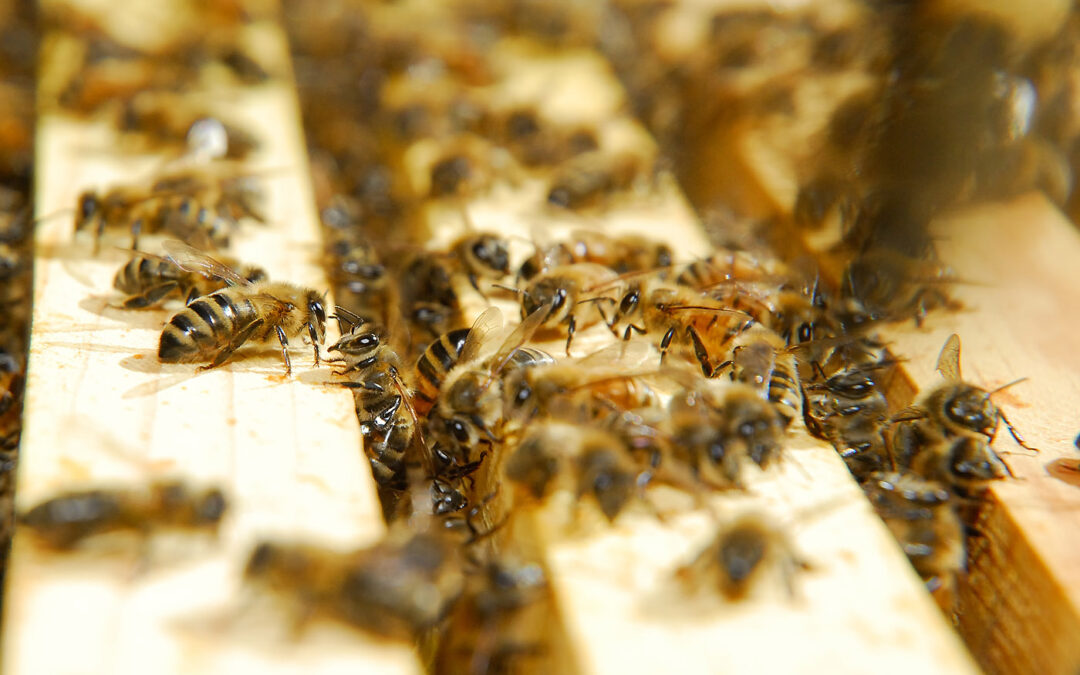
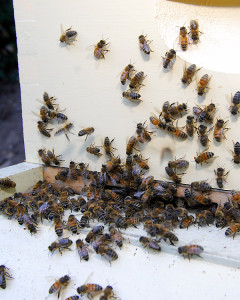
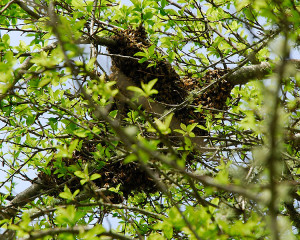
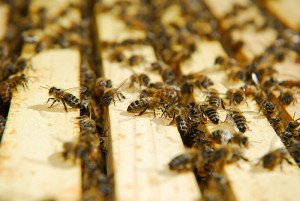
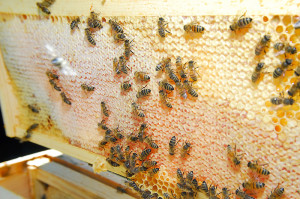
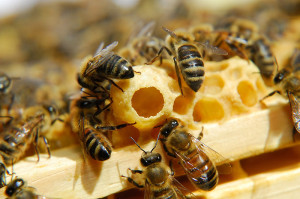
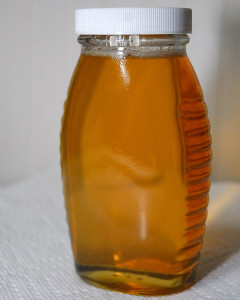







I have a queen named Rosemary too 🙂
In this case, we now have a Queen named “Rosemary 2” 😉 I hope this Rosemary fares better than the last!
I always love reading about your bees. It is so fascinating to learn about their intricate lives.
Even after a year of beekeeping, I’m still just as intrigued by bees as I’ve ever been. They really are remarkable insects!
I was wondering if you’ve gotten any honey yet, and you answered it. Congratulations!
Yes, just a little honey. Rosemary (the original hive) had quite a lot of honey in the hive when the Queen flew off, so we didn’t feel too bad taking a frame. We gave the rest to Salvia and Rosemary though, as we’d rather they had honey, than us having to feed sugar over the winter. They seem to have done well on it! 😉
Wonderful news that you could divide the hive and you have so much yummy honey…looking forward to seeing how these hives do…
I’m hoping this split will do well. It’s a little early in the season, but this hive is so strong, that even if this split failed, we could easily split it again in a few weeks.
I LOVE the adventure! Thanks for the blog!
We love it too! Never a dull moment in our apiary, but it’s nice report on some good news for a change. Last fall, with all the Varroa, really had me worried.
Clare, I”m thrilled to hear this hive is doing so well and has made it through the winter unscathed. You had me a bit worried when the other two hives collapsed.
It didn’t bode well losing that first hive in October, although we weren’t too surprised to lose Chamomile. We were shocked that the original Rosemary colony crashed so hard though. In both cases I really wonder if those Italian Queens produced enough winter bees. It was strange seeing that hive in January with so much honey, and so few bees. These ferals though are doing great!
Thanks for taking a break from preparing for the goats to write about the split. Several questions ….
Are the drawn comb frames the ones that the previous Rosemary tenants used? If so, did you need to do anything to clean them up before reuse?
and how is Lavender doing? you might split Salvia a second time before splitting Lavender once?
Some of the frames are from Rosemary, and some from Chamomile and Lavender too, when we removed extra boxes in the fall. Most of the frames were empty (those that had honey in them we distributed among the active hives). A few frames had pollen, and we brought those in for the winter to protect them from wax moth, but we’ll let the bees clean them out. If they chose to seal the pollen cells up, we can replace those frames with new foundation later in the spring.
We did check to be sure there were no obvious signs of infectious disease in both the Chamomile and Rosemary frames though (like Foul Brood), so we don’t inadvertently cause harm to our good colonies.
Some of the new frames we added on Friday, although not many, are brand new, with new wax foundation, but any frame we put within the brood nest had empty drawn out comb, and those were old honey frames from last year. You don’t want to put new foundation in the brood nest, at least not this time of year, as the bees need to build population, not draw wax. Well, maybe not Salvia so much, she already has tons of population, but the conventional wisdom is not to force them to build wax in the brood nest this early.
Lavender is doing very well too. We haven’t opened that hive yet, but the activity at their entrance is almost as much as Salvia, so we’ll split Lavender into the empty Chamomile hive next, and then look at splitting Salvia a second time in late March early April. I’m hoping, weather permitting, to split Lavender in the next week or two, or we could lose her to a swarm too.
Clare,
Hope all goes right, that hive was really full! I expect you will be able to do another split. I did our first powered sugar treatment last Friday, still dropping lots of varroa, will give them more as soon as the weather dries up. Still I have not seen one varroa on any bees or larva like you find. Beetles are back, killed close to 35 of them in the past weekend. Jealous of that honey, thought it looks like we’ll have some also. Oh can’t you borrow an extractor from your local bee club?
Most of the Varroa I find on the bees are usually in the photographs I take during inspections. Although this time I did spot a couple of mites on the bees while we were working the boxes. The brood didn’t seem as badly infested as late last summer, but that’s probably becuse they’re only just building up again from winter. That said though, the bees don’t seem to get much of a break from the mites. I actually wonder if Salvia stopped laying eggs over winter. She might not have considering how mild our weather was. Still glad I haven’t (yet) seen a small hive beetle though.
One of our local bee guilds has 3 or 4 extractors available to members. I think we’ll be able to borrow one for a day or two. It will be much more efficient than the crush and strain method we used for this first jar 😉
Well there never seems to be a dull moment at Curbstone – really enjoyed reading this Clare and I’d never realised that you would be able to smell the actual honey from the hives while out in the garden. Hope all goes well with the Rosemary hive now.
I didn’t expect the honey/beeswax aroma to be so noticeable either. I think it was just a combination of a warm afternoon, a light breeze, and very VERY busy bees! 🙂
like Rosie, did not think that the aroma of beehives could be detected by us humans. Now bears might be another matter (do you have these at CV?)
Another immensely informative post from your bee keeper’s diary Clare. Just wondered what would stop the bees from returning next door as it were?
No, no bears. There used to be bears in these parts, but not since the early 20th Century when the last sow bear known in these parts was killed. We’d probably have a few less deer if we had bears 😉 Skunks love honey though, and we have LOTS of skunks! Fortunately our hives are inside the deer fence perimeter, so the skunks can’t get to them.
Some of the bees will drift back ‘home’ to the original hive. That’s part of why we added some extra capped brood to the new hive. Those new bees should orient to the new hive entrance. We’re also bribing the bees with a little extra food to try to encourage them to stay, at least until the new round of bees hatches.
Your bee adventures always make a good read. It is had to believe you were doing this for only one year with all the knowledge and experiences that you accumulated in that time. Bee keeping is a lot of work, but so rewarding in so many ways too.
This beekeeping year as flown by fast. I can’t believe it’s swarm season again. I think we feel a lot more comfortable with hive management this year, but I’m sure the bees still have a few surprises in store for us. They always seem to teach us something new.
I can almost taste that honey!
Our weather hasn’t been quite as warm as yours yet. Our bees have been out and about, but I haven’t opened the hive up yet. I do have some greens flowering in the greenhouse, and the workers have been in there gathering pollen. We should have trees blooming before long.
This honey was very full of flavor, nothing like the store bought over-filtered stuff. We didn’t quite have the right sized strainer, so there are even a few rogue wax flakes in this jar, but I don’t mind 😉
We’d like to take some of the honey early, rather than waiting for mid-spring nectar flow. Last year we tasted some honey from other hives near here, and once the oaks bloom in the spring, the honey can take on a more bitter, tannic flavor. This honey from the Rosemary hive wasn’t bitter at all, so hopefully if we harvest before the oaks flower, the honey will be sweet.
Fascinating post about splitting a colony! I love reading about people who keep bees. I look forward to reading more about the new colony. I’m crossing my fingers too that Rosemary can raise a new Queen. The honey in the last picture looks gorgeous, I bet it tastes heavenly!
We’ve been quite conservative about using this honey because we love the flavor. We’re trying to keep some to compare it to our early spring harvest. The wonderful thing about honey flavor is it can vary from one hive to the next (even when they’re as close to each other as our hives), and the flavors also vary from season to season. Different bees have different flower preferences, and of course the blooms shift through the season. We’re hoping to do a few smaller harvests through the year for a variety of honey flavors, rather than waiting and doing one big harvest at once. Of course, that depends on the bees, and whether they have extra to spare, but at the moment they seem to have plenty.
I can imagine your garden smelling of beeswax and honey! The word I think to describe Curbstone Valley is ‘Alive’, with so much rich activity going on. I hope all goes well with Rosemary 2 in raising a new queen. Enjoy your honey!
That hive was definitely ‘alive’! We didn’t disturb them during the coldest part of winter, but I wish I had a little bee-cam to see just how active they were over winter. There’s no question they’re off to a good start this season. Crossing my fingers that’s a sign of the start of a good beekeeping year!
Hi Clare,
Lovely photos and good luck with the division of the swarm!
Looking forward to more updates on the Bees as it has been really interesting watching their prograss (or lack there of 🙁 )
The bees have certainly had us questioning at times whether they’d even survive the winter months. We’ve been fortunate to have a mild winter this year. It will be interesting to see how different this year is, now that the colonies have most of the their hive structure built. I’m crossing my fingers for a little extra honey this year 🙂
Even though you didn’t see the Salvia queen, I bet she was watching you! Good luck on Rosemary 2.0 (cute name). It looks very promising, and that jar of honey looks scrumptious. I look forward to hearing about your honey harvest soon.
If the Salvia Queen wasn’t watching us, I’m sure her guard bees were 😉 We’ll post when do a larger harvest, as that will be a bit more involved. First we need to figure out where we’ll extract the honey though. It needs to be indoors somewhere, or we’ll be mobbed by bees looking for a sweet treat!
That honey looks so good! Hoping they raise another queen as good as Salvia already has!
Now I’m really anxious to hear more about the goats and the barn! Our weather has really gotten cold and wet, wish winter didn’t decide to arrive at the end of February!
No worries Catherine, I have a barn update planned for tomorrow (it’s supposed to rain, so I’ll probably be stuck indoors anyway). I’m grateful winter held off for a bit, or we wouldn’t have managed to get a barn built…in the middle of February! 😛 More tomorrow…I promise!
I think I may have to enact “imitation as flattery” with your idea of labeling hives with herb markers. That is one impressive hive, too! We lost our packaged bees during the wedding chaos of last season so we’ve ordered a nuc for this April. I may try to get a swarm for a 2nd hive, otherwise we’ll wait to split the first one.
Hi Clare,…I missed this post….Congratualtions on splitting the hive sucessfully. Does the smoke and bee suits completely prevent bee stings? I’m allergic and couldn’t be a bee keeper so I really enjoy your story of them.